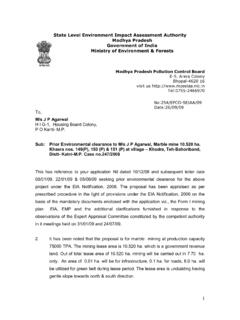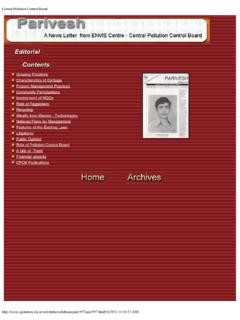Transcription of State Level Environment Impact Assessment …
1 1 State Level Environment Impact Assessment authority Madhya Pradesh Government of India Ministry of Environment & Forests Madhya Pradesh pollution control board E 5. Arera Colony Bhopal 4620 16 visit us Tel:0755 2466970 No:181/EPCO SEIAA/08 Date:08/10/08 To, M/s Ria Hotel Indore Shri Gurjeet Singh Chabra 1 AD, Scheme no 74 C Chabra House, Indore Sub: Environmental clearance for construction of Ria Hotel on plot no 12C C/A, 13C C/A, 14C C/A scheme no 94, Ring Road Indore, case no 1/2008. This has reference to your application No. Nil, dated 9 02 08 and subsequent letter date 19 06 2008, seeking prior environmental clearance for the above project under the EIA Notification, 2006. The proposal has been appraised as per prescribed procedure in the light of provisions under the EIA Notification, 2006 on the basis of the mandatory documents enclosed with the application viz., the Questionnaire, EIA, EMP and the additional clarifications furnished in response to the observations of the Expert Committee constituted by the competent authority in it meetings held on 09 04 08 and 19 08 08.
2 2. It is, interlalia, noted that the project involves the construction of a Hotel on a plot area of The total built up area proposed is The total water requirement proposed is KLD. The capacity of STP proposed is 150 KLD. The total solid waste generation will be MT/day. Total power requirement proposed is2 2000 KVA. Total parking spaces proposed are 200 ECS. The total cost of the project is crores. 3. The Expert Committee after due considerations of the relevant documents submitted by the project proponent and additional clarifications furnished in response to its observations have accorded environmental clearance as per the provisions of Environmental Impact Assessment Notification 2006 and its subsequent amendments, subject to strict compliance of the terms an conditions as follows: PART A SPECIFIC CONDITIONS I. Construction Phase i. Consent for Establishment shall be obtained from Madhya Pradesh pollution control board under Air and Water Act and a copy shall be submitted to the competent authority before start of any construction work at the site.
3 Ii. All required sanitary and hygienic measures should be in place before starting construction activities and are to be maintained throughout the construction phase. iii. A First Aid Room will be provided in the project both during construction and operation of the project. iv. Adequate drinking water and sanitary facilities should be provided for construction workers at the site. Provision should be made for mobile toilets. The safe disposal of waste water and solid wastes generated during the construction phase should be ensured. v. Necessary arrangement shall be made for the disposal of treated waste water during vi. All the topsoil excavated during construction activities should be stored for use in horticulture/landscape development within the project site. vii. Disposal of waste material during construction phase should not create any adverse effect on the neighbouring communities and be disposed taking the necessary precautions for general safety and health aspects of people, only in approved sites with the approval of competent authority .
4 Viii. Construction spoils, including bituminous material and other hazardous materials, must not be allowed to contaminate watercourses and the dump sites for such material must be secured so that they should not leach into the ground water. ix. Any hazardous waste generated during construction phase, should be disposed off as per applicable rules and norms with necessary approvals of the Madhya Pradesh pollution control board . x. The diesel generator sets to be used during construction phase, should be low sulphur diesel type and should conform to Environment (Protection) Rules prescribed for air and noise emission standards. xi. The diesel required for operating DG sets shall be stored in underground tanks and if required, clearance from Chief Controller of Explosives shall be taken. xii. Vehicles hired for bringing construction material to the site should be in good condition and should have a pollution check certificate and should conform to applicable air and noise emission standards and should be operated only during non peak hours.
5 Xiii. Ambient noise levels should conform to residential standards both during day and night and incremental pollution loads on the ambient4 air and noise quality should be closely monitored during construction phase. Adequate measures should be made to reduce ambient air and noise Level during construction phase, so as to conform to the stipulated standards by CPCB/MPPCB. xiv. Fly ash should be used as building material in the construction as per the provisions of Fly ash Notification of September, 1999 and amended as on 27 th August, 2003. (The above condition is applicable only if the project site is located within the 100 Km of Thermal Power Stations). xv. Provision for plantation has to be made as per Madhya Pradesh Bhumi Vikas Nigam, 1984 subject to a minimum of 33% of the total plot area. xvi. As far as possible ready mixed concrete must be used in building construction.
6 Xvii. Water demand during construction should be reduced as much as possible by use of pre mixed concrete curing agents and other best practices. xviii. Permission to utilize water shall be obtained from the competent authority prior to construction/operation of the project. xix. Separation of grey and black water should be done by the use of dual plumbing line for separation of grey and black water. xx. Fixtures for showers, toilet flushing and drinking should be of low flow either by use of aerators or pressure reducing devices or sensor based control . xxi. Use of glass may be reduced by upto 40% to reduce the electricity consumption and load on air conditioning. If necessary, high quality double glass with special reflective coating in windows can be xxii. Roof should meet prescriptive requirement as per Energy Conservation Building Code by using appropriate thermal insulation material to fulfill requirement.
7 Xxiii. Opaque wall should meet prescriptive requirement as per Energy Conservation Building Code which is proposed to be mandatory for all air conditioned spaces while it is aspirational for non air conditioned spaces by use of appropriate thermal insulation material to fulfill requirement. xxiv. The approval of the competent authority shall be obtained for structural safety of the buildings due to earthquake, adequacy of fire fighting equipments, etc. as per National Building Code including protection measures from lightening etc. xxv. Regular supervision of the above and other measures for monitoring should be in place all through the construction phase, so as to avoid disturbance to the surroundings. xxvi. Under the provisions of Environment (Protection) Act, 1986, legal action shall be initiated against the project proponent if it is found that construction of the project has been started without obtaining environmental clearance.
8 II. Operation Phase i. The installation of the Sewage Treatment Plant (STP) should be certified by an independent expert and a report in this regard should be submitted to the competent authority before the project is commissioned for operation. Treated affluent emanating from STP shall be recycled/reused to the maximum extent possible. Treatment6 of 100% grey water by decentralized treatment should be done. Discharge of unused treated affluent shall conform to the norms and standards of the Madhya Pradesh pollution control board . Necessary measures should be made to mitigate the odour problem from STP. ii. The solid waste generated should be properly collected and segregated. Wet garbage should be composted and dry/inert solid waste should be disposed off to the approved sites for land filling after recovering recyclable material. iii. Diesel power generating sets proposed as source of back up power for elevators and common area illumination during operation phase should be of enclosed type and conform to rules made under the Environment (Protection) Act, 1986.
9 The height of stack of DG sets should be equal to the height needed for the combined capacity of all proposed DG sets. Low sulphur diesel must be used. The location of the DG sets may be decided with in consultation with Madhya Pradesh pollution control board . iv. Noise should be controlled to ensure that it does not exceed the prescribed standards. During night time the noise levels measured at the boundary of the building at the boundary of the building shall restricted to the permissible levels to comply with the prevalent regulations. v. The green belt of the adequate width and density preferably with local species along the periphery of the plot shall be raised so as to provide protection against particulates and noise. vi. Weep holes in the compound walls shall be provided to ensure natural drainage of rain water in the catchment area during the monsoon vii.
10 Rain water harvesting for roof run off and surface run off, as per the plan submitted should be implemented. Before recharging the surface run off , pre treatment must be done to remove suspended matter, oil and grease. The bore well for rainwater recharging should be kept a least 5 mts. above the highest ground water table. viii. The ground water Level and its quality should be monitored regularly in consultation with Central Ground Water authority . ix. A report on the energy conservation measures conforming to energy conservation norms finalize by Bureau of Energy Efficiency should be prepared incorporating details about building materials & technology, R& U Factors etc. and submit to the competent authority in three months time. x. Energy conservation measures like installation of CFLs/TFLs for the lighting the areas outside the building should be an integral part of the project design and should be in place before project commissioning.

